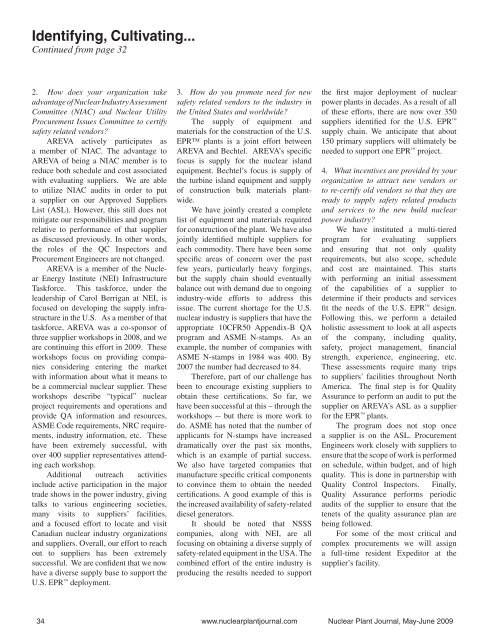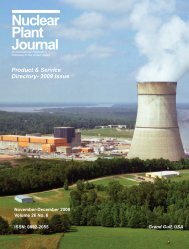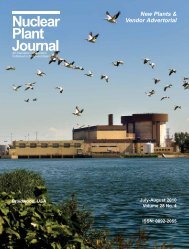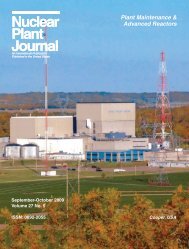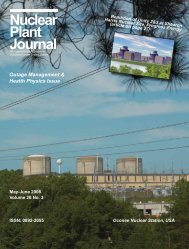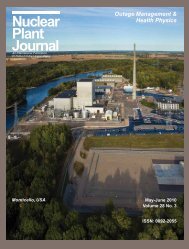Nuclear Plant Journal Outage Management ... - Digital Versions
Nuclear Plant Journal Outage Management ... - Digital Versions
Nuclear Plant Journal Outage Management ... - Digital Versions
Create successful ePaper yourself
Turn your PDF publications into a flip-book with our unique Google optimized e-Paper software.
Identifying, Cultivating...<br />
Continued from page 32<br />
2. How does your organization take<br />
advantage of <strong>Nuclear</strong> Industry Assessment<br />
Committee (NIAC) and <strong>Nuclear</strong> Utility<br />
Procurement Issues Committee to certify<br />
safety related vendors?<br />
AREVA actively participates as<br />
a member of NIAC. The advantage to<br />
AREVA of being a NIAC member is to<br />
reduce both schedule and cost associated<br />
with evaluating suppliers. We are able<br />
to utilize NIAC audits in order to put<br />
a supplier on our Approved Suppliers<br />
List (ASL). However, this still does not<br />
mitigate our responsibilities and program<br />
relative to performance of that supplier<br />
as discussed previously. In other words,<br />
the roles of the QC Inspectors and<br />
Procurement Engineers are not changed.<br />
AREVA is a member of the <strong>Nuclear</strong><br />
Energy Institute (NEI) Infrastructure<br />
Taskforce. This taskforce, under the<br />
leadership of Carol Berrigan at NEI, is<br />
focused on developing the supply infrastructure<br />
in the U.S. As a member of that<br />
taskforce, AREVA was a co-sponsor of<br />
three supplier workshops in 2008, and we<br />
are continuing this effort in 2009. These<br />
workshops focus on providing companies<br />
considering entering the market<br />
with information about what it means to<br />
be a commercial nuclear supplier. These<br />
workshops describe “typical” nuclear<br />
project requirements and operations and<br />
provide QA information and resources,<br />
ASME Code requirements, NRC requirements,<br />
industry information, etc. These<br />
have been extremely successful, with<br />
over 400 supplier representatives attending<br />
each workshop.<br />
Additional outreach activities<br />
include active participation in the major<br />
trade shows in the power industry, giving<br />
talks to various engineering societies,<br />
many visits to suppliers’ facilities,<br />
and a focused effort to locate and visit<br />
Canadian nuclear industry organizations<br />
and suppliers. Overall, our effort to reach<br />
out to suppliers has been extremely<br />
successful. We are confident that we now<br />
have a diverse supply base to support the<br />
U.S. EPR deployment.<br />
3. How do you promote need for new<br />
safety related vendors to the industry in<br />
the United States and worldwide?<br />
The supply of equipment and<br />
materials for the construction of the U.S.<br />
EPR plants is a joint effort between<br />
AREVA and Bechtel. AREVA’s specific<br />
focus is supply for the nuclear island<br />
equipment. Bechtel’s focus is supply of<br />
the turbine island equipment and supply<br />
of construction bulk materials plantwide.<br />
We have jointly created a complete<br />
list of equipment and materials required<br />
for construction of the plant. We have also<br />
jointly identified multiple suppliers for<br />
each commodity. There have been some<br />
specific areas of concern over the past<br />
few years, particularly heavy forgings,<br />
but the supply chain should eventually<br />
balance out with demand due to ongoing<br />
industry-wide efforts to address this<br />
issue. The current shortage for the U.S.<br />
nuclear industry is suppliers that have the<br />
appropriate 10CFR50 Appendix-B QA<br />
program and ASME N-stamps. As an<br />
example, the number of companies with<br />
ASME N-stamps in 1984 was 400. By<br />
2007 the number had decreased to 84.<br />
Therefore, part of our challenge has<br />
been to encourage existing suppliers to<br />
obtain these certifications. So far, we<br />
have been successful at this – through the<br />
workshops -- but there is more work to<br />
do. ASME has noted that the number of<br />
applicants for N-stamps have increased<br />
dramatically over the past six months,<br />
which is an example of partial success.<br />
We also have targeted companies that<br />
manufacture specific critical components<br />
to convince them to obtain the needed<br />
certifications. A good example of this is<br />
the increased availability of safety-related<br />
diesel generators.<br />
It should be noted that NSSS<br />
companies, along with NEI, are all<br />
focusing on obtaining a diverse supply of<br />
safety-related equipment in the USA. The<br />
combined effort of the entire industry is<br />
producing the results needed to support<br />
the first major deployment of nuclear<br />
power plants in decades. As a result of all<br />
of these efforts, there are now over 350<br />
suppliers identified for the U.S. EPR <br />
supply chain. We anticipate that about<br />
150 primary suppliers will ultimately be<br />
needed to support one EPR project.<br />
4. What incentives are provided by your<br />
organization to attract new vendors or<br />
to re-certify old vendors so that they are<br />
ready to supply safety related products<br />
and services to the new build nuclear<br />
power industry?<br />
We have instituted a multi-tiered<br />
program for evaluating suppliers<br />
and ensuring that not only quality<br />
requirements, but also scope, schedule<br />
and cost are maintained. This starts<br />
with performing an initial assessment<br />
of the capabilities of a supplier to<br />
determine if their products and services<br />
fit the needs of the U.S. EPR design.<br />
Following this, we perform a detailed<br />
holistic assessment to look at all aspects<br />
of the company, including quality,<br />
safety, project management, financial<br />
strength, experience, engineering, etc.<br />
These assessments require many trips<br />
to suppliers’ facilities throughout North<br />
America. The final step is for Quality<br />
Assurance to perform an audit to put the<br />
supplier on AREVA’s ASL as a supplier<br />
for the EPR plants.<br />
The program does not stop once<br />
a supplier is on the ASL. Procurement<br />
Engineers work closely with suppliers to<br />
ensure that the scope of work is performed<br />
on schedule, within budget, and of high<br />
quality. This is done in partnership with<br />
Quality Control Inspectors. Finally,<br />
Quality Assurance performs periodic<br />
audits of the supplier to ensure that the<br />
tenets of the quality assurance plan are<br />
being followed.<br />
For some of the most critical and<br />
complex procurements we will assign<br />
a full-time resident Expeditor at the<br />
supplier’s facility.<br />
34 www.nuclearplantjournal.com <strong>Nuclear</strong> <strong>Plant</strong> <strong>Journal</strong>, May-June 2009


